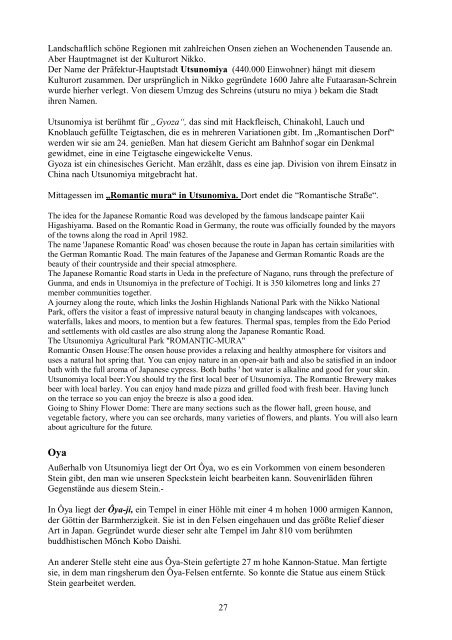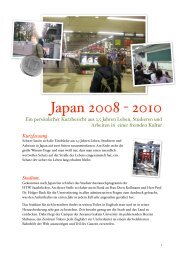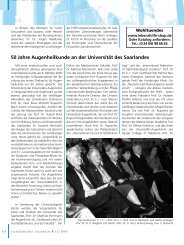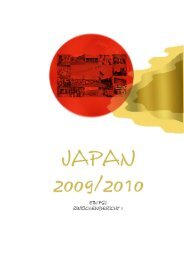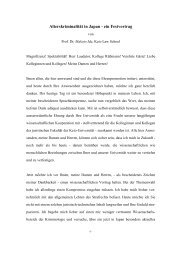Freundschaftsreise - Deutsch - Japanische Gesellschaft ( DJG ...
Freundschaftsreise - Deutsch - Japanische Gesellschaft ( DJG ...
Freundschaftsreise - Deutsch - Japanische Gesellschaft ( DJG ...
Erfolgreiche ePaper selbst erstellen
Machen Sie aus Ihren PDF Publikationen ein blätterbares Flipbook mit unserer einzigartigen Google optimierten e-Paper Software.
Landschaftlich schöne Regionen mit zahlreichen Onsen ziehen an Wochenenden Tausende an.<br />
Aber Hauptmagnet ist der Kulturort Nikko.<br />
Der Name der Präfektur-Hauptstadt Utsunomiya (440.000 Einwohner) hängt mit diesem<br />
Kulturort zusammen. Der ursprünglich in Nikko gegründete 1600 Jahre alte Futaarasan-Schrein<br />
wurde hierher verlegt. Von diesem Umzug des Schreins (utsuru no miya ) bekam die Stadt<br />
ihren Namen.<br />
Utsunomiya ist berühmt für „Gyoza“, das sind mit Hackfleisch, Chinakohl, Lauch und<br />
Knoblauch gefüllte Teigtaschen, die es in mehreren Variationen gibt. Im „Romantischen Dorf“<br />
werden wir sie am 24. genießen. Man hat diesem Gericht am Bahnhof sogar ein Denkmal<br />
gewidmet, eine in eine Teigtasche eingewickelte Venus.<br />
Gyoza ist ein chinesisches Gericht. Man erzählt, dass es eine jap. Division von ihrem Einsatz in<br />
China nach Utsunomiya mitgebracht hat.<br />
Mittagessen im „Romantic mura“ in Utsunomiya. Dort endet die “Romantische Straße“.<br />
The idea for the Japanese Romantic Road was developed by the famous landscape painter Kaii<br />
Higashiyama. Based on the Romantic Road in Germany, the route was officially founded by the mayors<br />
of the towns along the road in April 1982.<br />
The name 'Japanese Romantic Road' was chosen because the route in Japan has certain similarities with<br />
the German Romantic Road. The main features of the Japanese and German Romantic Roads are the<br />
beauty of their countryside and their special atmosphere.<br />
The Japanese Romantic Road starts in Ueda in the prefecture of Nagano, runs through the prefecture of<br />
Gunma, and ends in Utsunomiya in the prefecture of Tochigi. It is 350 kilometres long and links 27<br />
member communities together.<br />
A journey along the route, which links the Joshin Highlands National Park with the Nikko National<br />
Park, offers the visitor a feast of impressive natural beauty in changing landscapes with volcanoes,<br />
waterfalls, lakes and moors, to mention but a few features. Thermal spas, temples from the Edo Period<br />
and settlements with old castles are also strung along the Japanese Romantic Road.<br />
The Utsunomiya Agricultural Park "ROMANTIC-MURA"<br />
Romantic Onsen House:The onsen house provides a relaxing and healthy atmosphere for visitors and<br />
uses a natural hot spring that. You can enjoy nature in an open-air bath and also be satisfied in an indoor<br />
bath with the full aroma of Japanese cypress. Both baths ' hot water is alkaline and good for your skin.<br />
Utsunomiya local beer:You should try the first local beer of Utsunomiya. The Romantic Brewery makes<br />
beer with local barley. You can enjoy hand made pizza and grilled food with fresh beer. Having lunch<br />
on the terrace so you can enjoy the breeze is also a good idea.<br />
Going to Shiny Flower Dome: There are many sections such as the flower hall, green house, and<br />
vegetable factory, where you can see orchards, many varieties of flowers, and plants. You will also learn<br />
about agriculture for the future.<br />
Oya<br />
Außerhalb von Utsunomiya liegt der Ort Ôya, wo es ein Vorkommen von einem besonderen<br />
Stein gibt, den man wie unseren Speckstein leicht bearbeiten kann. Souvenirläden führen<br />
Gegenstände aus diesem Stein.-<br />
In Ôya liegt der Ôya-ji, ein Tempel in einer Höhle mit einer 4 m hohen 1000 armigen Kannon,<br />
der Göttin der Barmherzigkeit. Sie ist in den Felsen eingehauen und das größte Relief dieser<br />
Art in Japan. Gegründet wurde dieser sehr alte Tempel im Jahr 810 vom berühmten<br />
buddhistischen Mönch Kobo Daishi.<br />
An anderer Stelle steht eine aus Ôya-Stein gefertigte 27 m hohe Kannon-Statue. Man fertigte<br />
sie, in dem man ringsherum den Ôya-Felsen entfernte. So konnte die Statue aus einem Stück<br />
Stein gearbeitet werden.<br />
27


